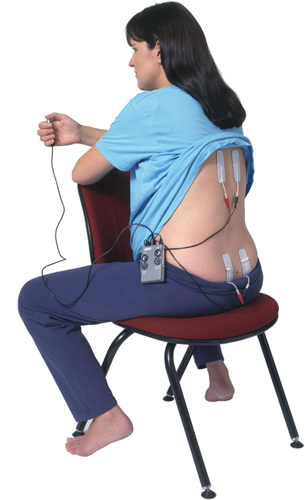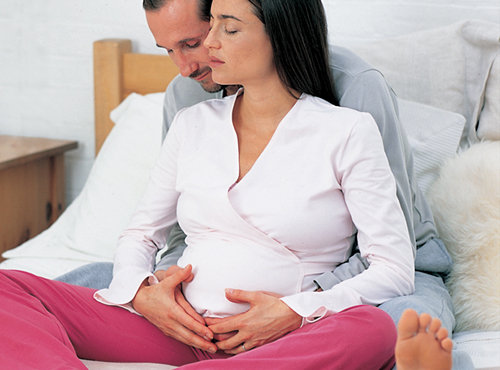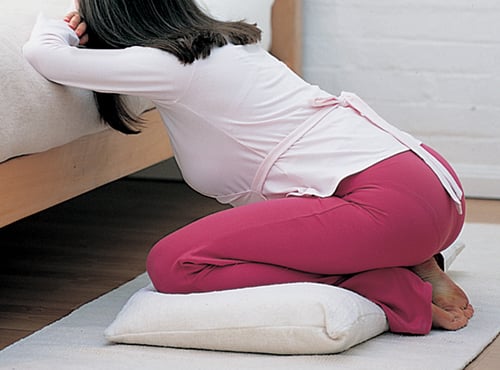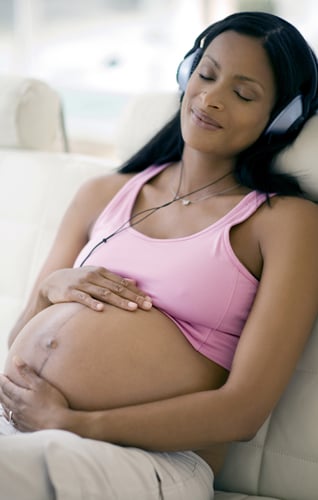Natural Pain Relief
Many women opt for natural pain relief in labor, or choose to complement medical pain relief with natural methods.
During your labor,
encephalins and endorphins (feel-good hormones) are released to provide
you with some naturally induced pain relief. Many women now are also
more aware of natural techniques, such as staying active, and of the
availability of complementary therapies that they can use in addition
to, or instead of, medical pain relief during pregnancy, childbirth, and
following the birth. Some of these therapies are self administered and
some are practitioner administered. A knowledge of the benefits of
different therapies and how to use them is important if you are
considering using them to deal with pain in labor.
Staying active
Being active in labor
has been shown to help women to deal with pain and reduce the length of
labor. Historically, women have been active in labor for centuries, but a
medicalization of childbirth in the West led to an acceptance that
women lie in bed, and a common image of a laboring woman is one lying in
bed. Although during labor you may want to rest on a bed between
contractions, many women find that when they feel supported, they will
instinctively move around and do not cope well lying down, which can
increase pain and hamper the progress of labor as your baby pushes
against gravity. You may find it helpful to take a walk, roll on a
birthing ball, rock in a rocking chair or change positions when you get
too uncomfortable. There are certain interventions, such as the use of electronic fetal monitoring, IVs, and some types of analgesia, that will limit your mobility.
TENS
TENS stands for
Transcutaneous Electrical Nerve Stimulation, and is a small electrical
device that reduces pain signals sent to the brain. In addition to being
used in labor, the device can also be used at the end of pregnancy
(after 36 weeks) if you have a backache or uncomfortable Braxton Hicks’ contractions.
The battery-operated
TENS machine has thin wires that are connected to four electrodes, or
sticky pads, which are taped to the lower back. The machine is thought
to work by sending electrical impulses from the machine along nerve
roots to the pain pathways in the brain, thereby blocking pain impulses.
It’s also thought to stimulate the brain to produce “feel good”
encephalins and endorphins, which can modulate the pain.
TENS is most
effective in early labor, particularly for lower back pain, and it is
therefore important to have the device available at the beginning of
labor. It’s therefore worth finding out if your hospital has TENS
machines or whether you need to rent one in advance. You can hold the
device or have it near you in labor and can increase the strength of the
electrical impulse with a button as your contractions get stronger.
There are several
advantages to TENS. It has few side effects; it allows you to remain
active; and it can be used in combination with other types of pain
relief. The disadvantages are that there hasn’t been much research done
about its safety for the baby, so a theoretical risk exists, and it is
generally effective with just mild to moderate pain; the sticky pads
mean that a back massage is not possible; and it isn’t possible to labor
in water or have an epidural inserted while using the device.
Once the electrodes for TENS are positioned on your back, you will be free to move around and find comfortable positions.

Water
Many women find being in
warm water during labor very soothing and an excellent way to cope with
labor pain. The warmth of the water soothes muscles, promoting
relaxation, and being in water aids buoyancy, which can help relieve the
pressure on your pelvis. Over the last decade or so, this natural
method has become more available for women and many hospitals and birth
centers provide bathtubs. Whether or not you can actually deliver your
baby in the water will depend on the hospital’s policy and whether there
are any doctors or midwives trained in water births. You can also purchase or rent a birthing pool.
Hypnosis
Self-hypnosis, using
visualization and breathing techniques to induce a state of deep
relaxation and banish fear, is an increasingly popular means of dealing
with labor, and is referred to as “HypnoBirthing.” This is based on the
“fear-tension-pain” syndrome of childbirth first described by the
English obstetrician Grantly Dick-Read
who believed that fear prevents the release of the “feel good
hormones,” endorphins and encephalins. He maintained that when fear is
eliminated, most women can give birth naturally. With HypnoBirthing, you
are fully aware of what is happening around you, but may feel as though
you’re daydreaming or drifting off to sleep. You and your birth partner
can attend HypnoBirthing classes anytime during pregnancy to learn the
techniques before labor.
Acupuncture
This uses fine
needles placed at specific points on the body to reduce pain by
stimulating the production of endorphins. Acupuncture is a traditional
form of Chinese medicine that believes there are channels within the
body through which energy, or “chi” runs. Blockages can occur in these
channels, and so by inserting needles at certain points, energy is
unblocked, relieving pain and restoring balance to the body. Many women
find acupuncture helpful to treat mild pregnancy symptoms, and some
women use this therapy during labor. Acupuncture has no harmful side
effects for the mother or baby and in labor, needles will usually be
inserted in points that do not restrict your movement, for example in
the ear. If you want to have acupuncture during labor, you will need to
look for an acupuncturist who specializes in this area and arrange to
have him or her with you during labor.
Homeopathy
This is based on the
principle of treating like with like. Talk to your doctor before using
any homeopathic products during pregnancy or labor, since homeopathy is
an area of complementary and alternative medicine that’s associated with
much debate and scientific controversy. If your doctor gives you the
okay, a certified homeopath can prescribe remedies based on your
individual needs. There is a lack of scientific evidence on the
effectiveness of homeopathy, although many women find the remedies
helpful.
Aromatherapy
Aromatherapy (essential)
oils are derived from plants and used for their therapeutic properties.
The use of these oils in childbirth can stimulate, refresh, and soothe
you and to some extent your partner. There is some evidence that oils,
such as lavender, reduce anxiety in labor, which in turn helps you cope
with pain. Hot and cold compresses with essential oils added to the
water used to wet the cloth can be soothing and massaging diluted
essential oils (in a carrier oil) into the skin is therapeutic. Many
experts recommend against aromatherapy during pregnancy and labor
because some scents may be hazardous to pregnant women. The effects of
most plant oils on pregnant women is unknown.
Reflexology
Reflexology
involves massaging reflex zones on your feet that correspond with
different parts of your body to improve your blood circulation and relax
any tension you may be feeling. Reflexology is gaining some popularity
as a coping technique in the early stages of labor. However, because
many women naturally want to be active and move around during their
labor, this may be more helpful in between early contractions.
Relaxation techniques
There are various techniques you can use to help you relax during labor;
if you’re relaxed, it will be easier to stay calm and in tune with your
body. These techniques include focusing on your breathing (see Concentrating on your breathing); listening to music (perhaps humming to the beat of a favorite tune during a contraction); and listening to a meditation CD.
Learning how to breathe
slowly and steadily in labor helps you focus and stay calm. Usually,
your breathing responds to how you’re feeling and may increase slightly
during a contraction, or you may hold your breath, which can make you
feel light-headed. If this happens, you need to focus and steady your
breathing. Your nurse will remind you to breathe slowly and steadily.
Breathing in for five and out for seven slows your breathing down, helps
you relax, and stops you from panicking.
Concentrating on your breathing in labor is calming and helps you focus.

Leaning forward while breathing steadily can be comforting during contractions.

Listening to some of your favorite music
in the first stage of labor is a great way to relax between
contractions, enabling you to let go and reserve energy for later in
labor.

| Q: |
Will I be able to stay active in labor?
|
| A: |
Yes, most women are able to remain active through labor and are
encouraged to do so, perhaps using props such as a chair, beanbag, or
birthing ball. Staying active can help since this can speed up labor,
and changing your position can help you deal with labor pain. When you
arrive at the hospital or birth center, discuss your birth plan with the
doctor and inform her that you want to be as active as possible.
|
| Q: |
Will I lose control if I use hypnosis during my labor?
|
| A: |
No, you will simply feel deeply relaxed, but will still be in
control and know what you are doing. Don’t worry—self-hypnosis will help
you be less anxious and frightened during your labor, which will help
you to deal with labor pain. With preparation, your partner can help you
stay focused and use some hypnotic techniques too.
|
| Q: |
I’ve had a previous cesarean. Does this mean that I won’t be able to labor in water this time?
|
| A: |
It depends on the procedures that your health-care provider
follows for women who have already had a cesarean. After a cesarean, the
doctors will want to monitor you and the baby either continuously or
frequently during labor, because there is a very small chance that your
uterus may rupture, which is often only detected through a change in the
baby’s heartbeat. But waterproof monitoring systems are widely
available and many practices perform WBAC—water birth after cesarean.
|
| Q: |
At what point can I get into the birthing pool?
|
| A: |
This is up to you. Relaxing in warm water is often suggested in
the early stages of labor, as long as your contractions are
progressing. You can sit in the warm water for 11/2 to 2 hours for pain
management, but then get out. Changing your environment helps keep your
labor active.
|